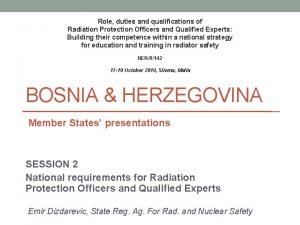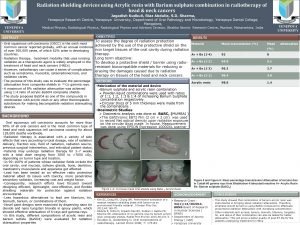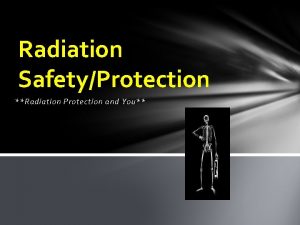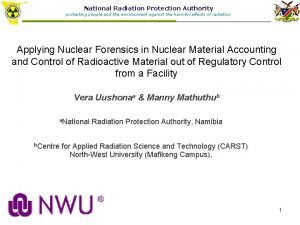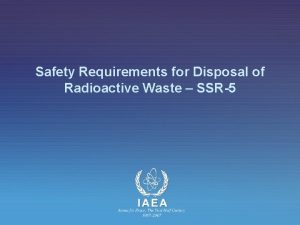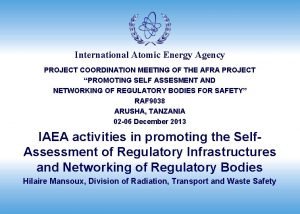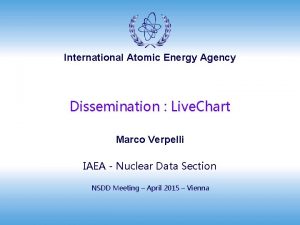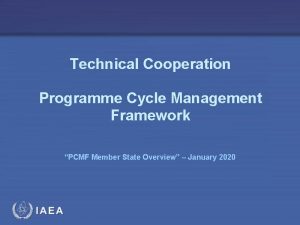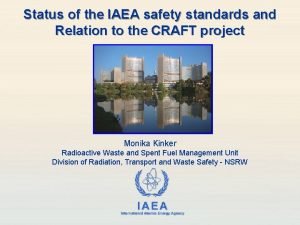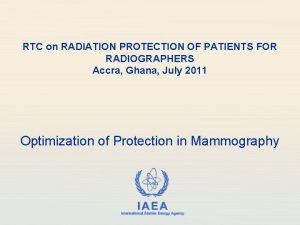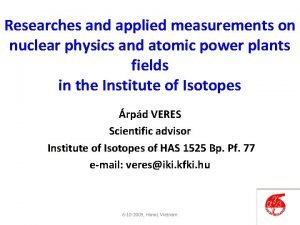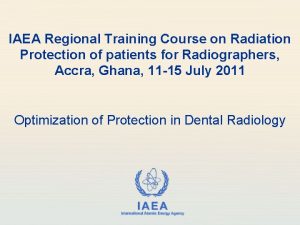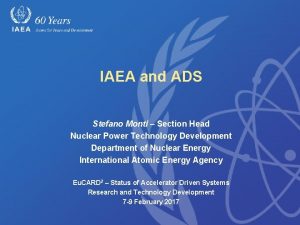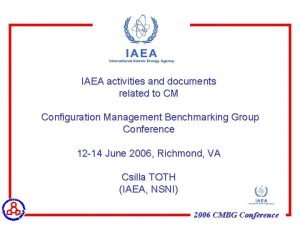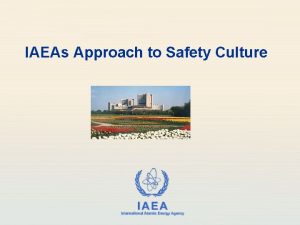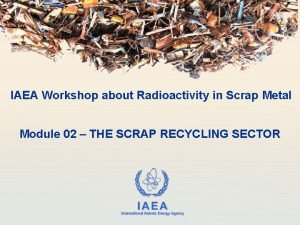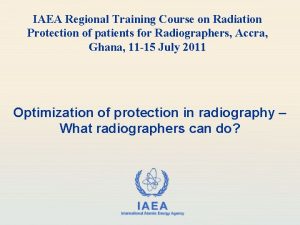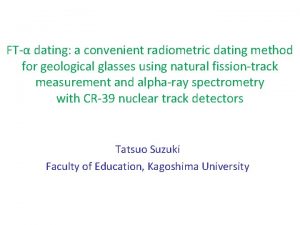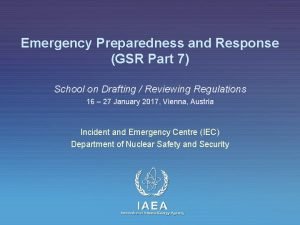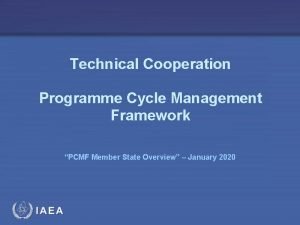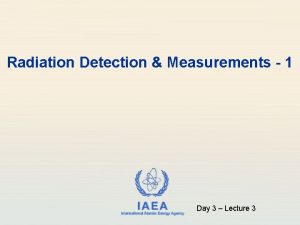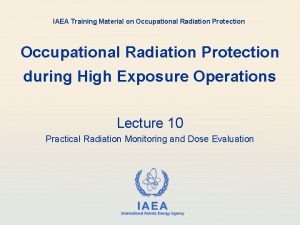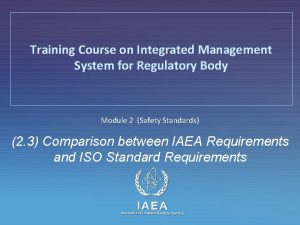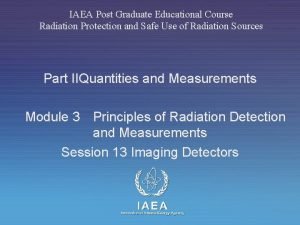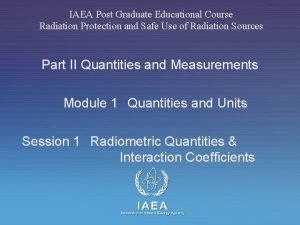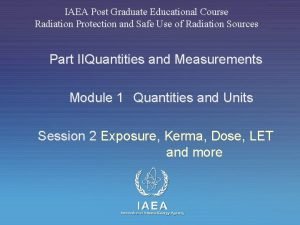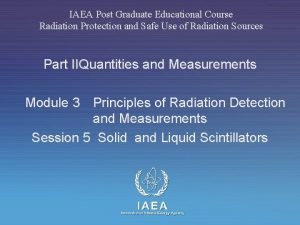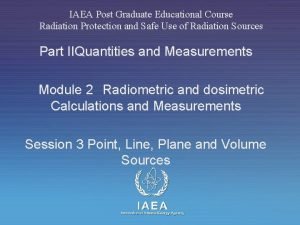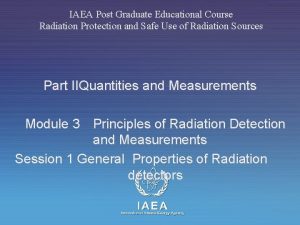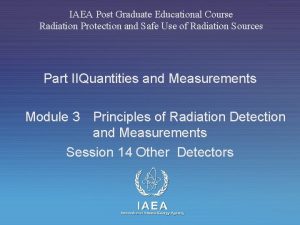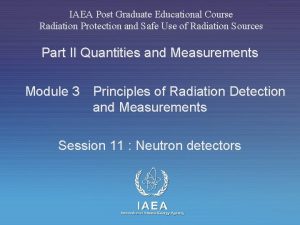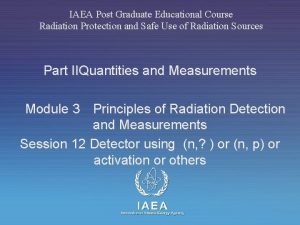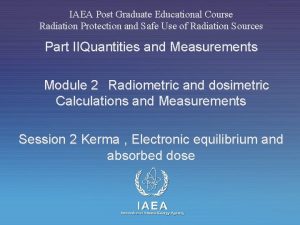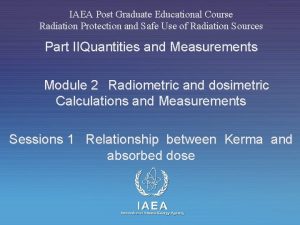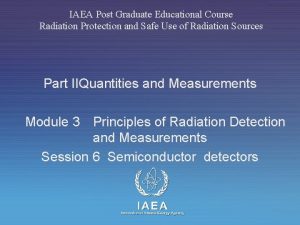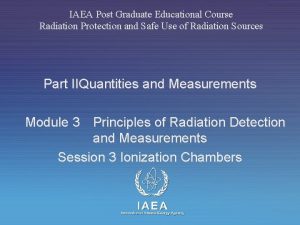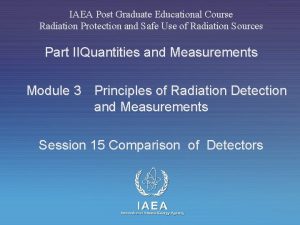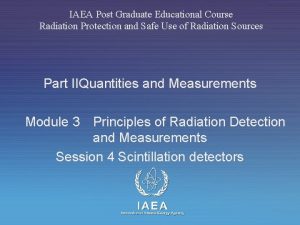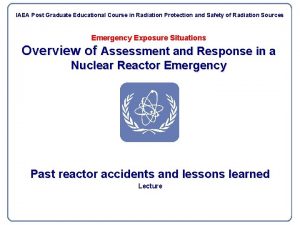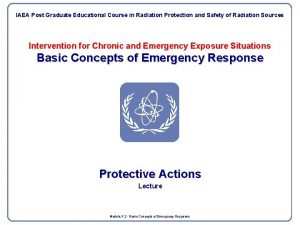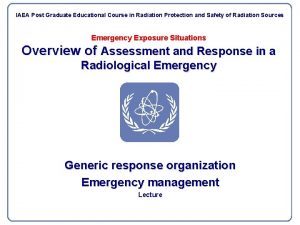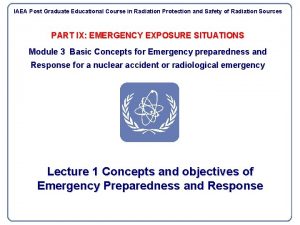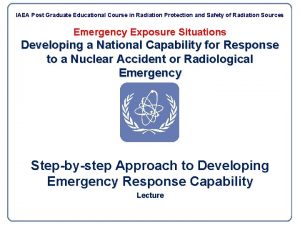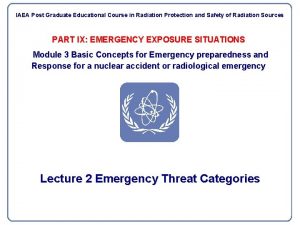IAEA Post Graduate Educational Course in Radiation Protection






















- Slides: 22

IAEA Post Graduate Educational Course in Radiation Protection and Safety of Radiation Sources Intervention for Chronic and Emergency Exposure Situations Module IX Basic Concepts for Emergency preparedness and Response for a nuclear accident or radiological emergency Principles of Intervention Lecture Module IX. 3 - Basic Concepts

Introduction l l l In the event of an accident doses to individuals in the population can only be reduced by intervention Broad international accord on the principles and objectives of interventions has been achieved The objective of the lesson is to present internationally recognized system of radiation protection for interventions Module IX. 3 - Basic Concepts 2

Content l l l System of Protective Actions and other Response Actions Generic Criteria for Protective Action Basis for Operational Criteria Emergency workers – basic philosophy Summary Module IX. 3 - Basic Concepts 3

System of Protective Actions and other Response Actions l The system of protective actions and other response actions in an emergency includes numerical values of generic criteria as well as of the corresponding operational criteria that form the basis for decision making in an emergency. Module IX. 3 - Basic Concepts 4

System of Protective Actions and other Response Actions Module IX. 3 - Basic Concepts 5

System of Protective Actions and other Response Actions The following considerations form the basis of this system: l Considers the possible outcomes. l Consider the types of exposures. l Implement precautionary urgent protective actions. l Implement urgent and early protective action and other response action to reduce risk. l Provided with medical attention if the dose exceeds a particular generic criteria. l Decision maker and public should be informed about the risks in plain language explanation. Module IX. 3 - Basic Concepts 6

Generic Criteria for Protective Action Module IX. 3 - Basic Concepts 7

Generic Criteria for Protective Action l l In the absence of national guidance, the generic criteria presented in Acute Dosis and Protective Action could be used as a basis for the development of criteria at the national level. If a reference level different from 20– 100 m. Sv is chosen, appropriate scaling of the values of the generic criteria in Table 3 should be carried out, with account taken of the time frame (acute or annual) of the reference level. In exceptional circumstances, higher values of the generic criteria may be necessary. Module IX. 3 - Basic Concepts 8

Generic Criteria for Acute Doses Module IX. 3 - Basic Concepts 9

Generic Criteria for Protective Action Module IX. 3 - Basic Concepts 10

Example of Some Generic OILs Nuclear accident Protective action Generic OIL Operational quantity Evacuation Substantial shelter 1 m. Sv/h Dose rate in plume Iodine prophylaxis Sheltering 0. 1 m. Sv/h Dose rate in plume Precautionary food restriction 0. 1 μSv/h Dose rate from deposition Consumption restrictions (general food) I-131: 10 k. Bq/m 2 Cs-137: 2 k. Bq/m 2 Ground deposition levels Module IX. 3 - Basic Concepts 11

Basis for Operational Criteria l l l Substantial risk Projected dose Dose that has been received Module IX. 3 - Basic Concepts 12

Basis for Operational Criteria l Substantial Risk n result in early deaths or other severe deterministic effects n is the basis for operational criteria for decision makers n Justified the need for urgent protective actions n appropriate arrangements in place Module IX. 3 - Basic Concepts 13

Basis for Operational Criteria Projected dose n Three objectives s To prevent severe deterministic effects s To take effective protective actions and other response actions s To ensure the safety of emergency workers n n n To introduce urgent protective actions To consider the uncertainty in the dose distribution in the population The generic criteria are given separately for intake of radioactive material and for external exposure. Module IX. 3 - Basic Concepts 14

Basis for Operational Criteria l Projected dose n The RBE weighted averaged absorbed dose in an organ or tissue is defined as the product of the averaged absorbed dose in an organ or tissue and the RBE n The sum of the RBE weighted absorbed doses for intake of radioactive material and for external exposure may be used as a basis for calculation of OILs for decision making purposes n The generic criteria should be used to derive OILs Module IX. 3 - Basic Concepts 15

Basis for Operational Criteria Dose that has been received l to distinguish between the planning stage and an actual situation l basis for operational criteria: n To provide medical care n To consider the need for medical follow-up n To provide counselling to those exposed n To provide a basis for reassuring l supports decisions for urgent and longer term medical actions Module IX. 3 - Basic Concepts 16

Basis for Operational Criteria Dose that has been received. l To determinate the cause of the symptoms requires analysis by experts. l The reason for follow-up studies should be carefully explained to those involved. l Long term medical follow-up is justified to detect and treat late deterministic effects. l Epidemiological studies have not demonstrated such effects in individuals exposed at low doses (less than 0. 1 Sv) delivered over a period of many years. l Assessment of long term follow-up after the Module IX. 3 - Basic Concepts 17

Emergency Workers – Basic Philosophy l Members of the public will receive doses unless some action is taken to prevent it l Emergency workers will not receive doses unless a decision is made to expose them to the source (except during the initial course of an accident) Module IX. 3 - Basic Concepts 18

Emergency Workers – cont’d l l l The exposure to the source of radiation should be justified The protection against radiation from the source should be optimized Three categories of working conditions are defined Module IX. 3 - Basic Concepts 19

Categories of Accident Related Work l l Category 1: Saving life and/or preventing severe consequences Category 2: Short term recovery operations and/or urgent protective actions affecting the public Category 3: Longer term recovery operations Work not directly connected to the accident Module IX. 3 - Basic Concepts 20

Summary l l Experience has shown that integrated system of guidance is necessary for taking consistent protective actions Generic criteria are based on current knowledge of deterministic and stochastic effects Generic criteria presented could be used as a basis for the development of criteria at the national level Emergency worker protection follows basically the same “intervention” principles Module IX. 3 - Basic Concepts 21

Where to Get More Information IAEA Criteria for use in preparedness and response for a nuclear or radiological emergency, General Safety Guide No. GSG -2, Vienna 2011 Module IX. 3 - Basic Concepts 22
 Radiation protection officer qualifications
Radiation protection officer qualifications Barium sulphate board for radiation protection
Barium sulphate board for radiation protection Cardinal principles of radiation protection
Cardinal principles of radiation protection National radiation protection authority namibia
National radiation protection authority namibia Ssr-5
Ssr-5 Saris iaea
Saris iaea Iaea livechart
Iaea livechart Succequent
Succequent Iaea gsr part 4
Iaea gsr part 4 Rtc protective film
Rtc protective film Nuclear wastes
Nuclear wastes Iaea
Iaea Stefano monti iaea
Stefano monti iaea Iaea
Iaea Iaea
Iaea Iaea
Iaea Iaea
Iaea Iaea
Iaea Iaea gsr part 7
Iaea gsr part 7 Iaea pcmf
Iaea pcmf Film badge dosimeter
Film badge dosimeter Iaea
Iaea Integrated management systems training north america
Integrated management systems training north america
